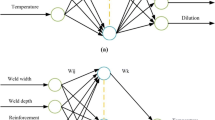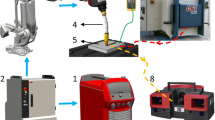Abstract
Prediction of weld bead shapes prior to welding has been a challenge for researchers in recent years. The assurance of a weld shape with adequate penetration and dilution, good wetting angles and no undercuts leads to less repairing and reworking and thus, lower cost and time consumed. CMT is a variant of MIG/MAG welding process recently introduced in the market. Software control for bead-shape prediction helps the user to get familiar with this modern technology. In the present paper, two approaches were undertaken for software development. These were applied to CMT and pulsed-MAG welding and the results were compared. The graphical interface was built to help the user choose the welding parameters and get the representation of the weld bead profile. The two approaches used to predict the weld bead profiles are neural networks and interpolation method. The data entries for the two different methods are: welding process (CMT and MAG-pulsed), plate thickness, travel speed and wire feed speed. The output data is the complete welding profile defined by X and Y coordinates of the points on the welding profile. The neural networks were trained with different numbers of neurons, multiple layers and different networks, and welding data bases with different structures were used, in order to find the best fitting neural network. The final results for each method were checked against real profiles and it was concluded that the neural network method was more flexible and the accuracy of each methods was nearly the same.
Similar content being viewed by others
References
Furukawa K (2006) New CMT arc welding process—welding of steel to aluminium dissimilar metals and welding of super-thin aluminium sheets. Weld Int 20:440–445
Pires I, Quintino L, Amaral V, Rosado T (2010) Reduction of fume and gas emissions using innovative gas metal arc welding variants. Int J Adv Manuf Technol 50:557–567
Lorenzin G, Rutili G (2009) The innovative use of low heat input in welding: experiences on “cladding” and brazing using the CMT process. Weld Int 23:622–632
Thao DT, Jeong JW, Kim IS, Kim JWHJ (2008) Predicting lap-joint bead geometry in GMA welding process. Arch Mater Sci Eng 32:121–124
Palani PK, Murugan N (2006) Development of mathematical models for prediction of weld bead geometry in cladding by flux cored arc welding. Int J Adv Manuf Technol 30:669–676
Murugan N, Gunaraj V (2000) Prediction and optimization of weld bead volume for the submerged arc process—part 1. Weld J 79:286–294
Dey V, Pratihar DK, Datta GL, Jha MN, Saha TK, Bapat AV (2009) Optimization and prediction of weldment profile in bead-on-plate welding of Al-1100 plates using electron beam. Int J Adv Manuf Technol 48:513–528
Karray FO, Silva CWD (2004) Soft Computing and Intelligent Systems Design: Theory, Tools and Applications. Addison Wesley, New York
Andersen K, Cook GE, Karsai G, Ramaswamy K (1990) Artificial neural networks applied to arc welding process modeling and control. IEEE Trans Ind Appl 26:824–830
Pal S, Samantaray A (2008) Artificial neural network modeling of weld joint strength prediction of a pulsed metal inert gas welding process using arc signals. J Mater Process Technol 202:464–474
Kim I, Son J, Park C, Lee C, Prasad YKD (2002) A study on prediction of bead height in robotic arc welding using a neural network. J Mater Process Technol 131:229–234
Jeng J-Y, Mau T-F, Leu S-M (2000) Prediction of laser butt joint welding parameters using back propagation and learning vector quantization networks. J Mater Process Technol 99:207–218
Manikya Kanti K, Srinivasa Rao P (2008) Prediction of bead geometry in pulsed GMA welding using back propagation neural network. J Mater Process Technol 200:300–305
Nagesh DS, Datta GL (2002) Prediction of weld bead geometry and penetration in shielded metal-arc welding using artificial neural networks. J Mater Process Technol 123:303–312
Sathiya P, Jinu GR, Singh N (2009) Simulation of weld bead geometry in GTA welded duplex stainless steel (DSS). Sch Res Exch 2009:1–9
Shanmugam NS, Buvanashekaran G, Sankaranarayanasamy K, Ramesh Kumar S (2010) A transient finite element simulation of the temperature and bead profiles of T-joint laser welds. Mater Des 31:4528–4542
Chapman SJ (2003) Programação em MatLab para engenheiros. Cengage Learning, São Paulo
Kou S (2002) Welding metallurgy. Wiley, New York
Demuth H (2009) Neural Network Toolbox TM 6 User’ s Guide
Author information
Authors and Affiliations
Corresponding author
Rights and permissions
About this article
Cite this article
Meco, S., Pardal, G., Eder, A. et al. Software development for prediction of the weld bead in CMT and pulsed-MAG processes. Int J Adv Manuf Technol 64, 171–178 (2013). https://doi.org/10.1007/s00170-012-3990-x
Received:
Accepted:
Published:
Issue Date:
DOI: https://doi.org/10.1007/s00170-012-3990-x




